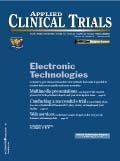Multimedia Delivery Can Enhance the Consent Process
New technologies allow prospective subjects to absorb information about a trial at each individual?s pace.
Recent deaths of human subjects at leading medical research facilities and the consequent major lawsuits leveled against those facilities have brought the current consent process under attack. Human subject advocacy groups, federal institutions, trial attorneys, and medical ethiciststo name a few of the interested groupshave all called for an improved consent process.13 Such a process must fully educate subjects about a clinical trial protocol and the trials purpose, risks, and expected results. The financial backers of the trial and the possible financial beneficiaries must be made known, and potential conflicts of interest must be disclosed. The informed consent of the future will verify that the subject truly understands these concepts, and that all concerns have been resolved prior to consent being given. This is the ideal of informed consent that the clinical trials industry seeks and, for its own protection, must soon adopt.
New technologies, such as multimedia presentations, aim to rectify the deficiencies of the current consent process. These presentations educate the subject through a variety of teaching techniquesnarration, illustrations, photos, text, and animationsthat now seem commonplace in our television-based society. More than a quixotic hope for the future, enhanced informed consent technology has already been implemented in several leading research centers. These multimedia technologies claim to deliver benefits to both the investigative team and the subject, and may soon prove to be a revolutionizing force in the consent process.
Problems in the current consent process
Several factors are hampering current efforts to provide research subjects with a comprehensive consent experience. A few of these factors include:

Improving Relationships and Diversifying the Site Selection Process
April 17th 2025In this episode of the Applied Clinical Trials Podcast, Liz Beatty, co-founder and chief strategy officer, Inato, discusses a number of topics around site engagement including community-based sites, the role of technology in improving site/sponsor relationships, how increased operational costs are impacting the industry, and more.
Behind the Buzz: Why Clinical Research Leaders Flock to SCOPE Summit
February 7th 2025In this episode, we meet with Micah Lieberman, Executive Conference Director for SCOPE Summit (Summit for Clinical Ops Executives) at Cambridge Innovation Institute. We will dive deep into the critical role of collaboration within the clinical research ecosystem. How do we bring together diverse stakeholders—sponsors, CROs, clinical trial tech innovators, suppliers, patients, sites, advocacy organizations, investors, and non-profits—to share best practices in trial design, program planning, innovation, and clinical operations? We’ll explore why it’s vital for thought leaders to step beyond their own organizations and learn from others, exchanging ideas that drive advancements in clinical research. Additionally, we’ll discuss the pivotal role of scientific conferences like SCOPE Summit in fostering these essential connections and collaborations, helping shape the future of clinical trials. Join us as we uncover how collective wisdom and cross-industry partnerships are transforming the landscape of clinical research.